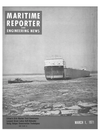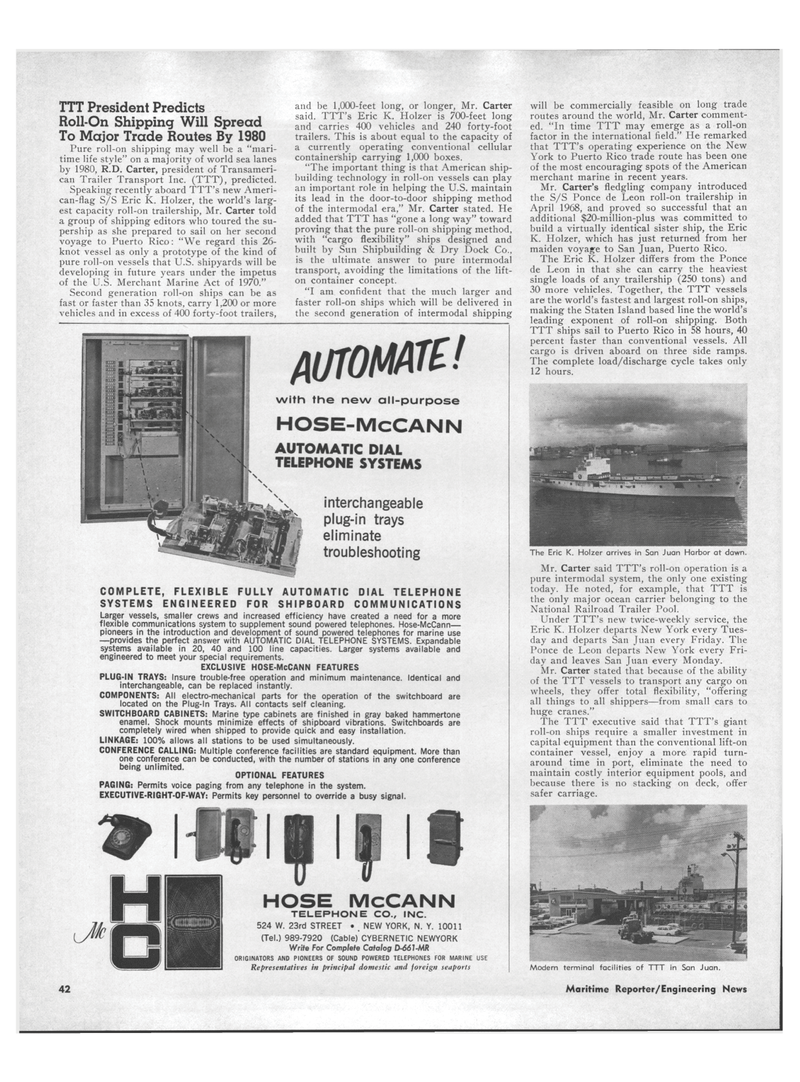
Page 40: of Maritime Reporter Magazine (March 1971)
Read this page in Pdf, Flash or Html5 edition of March 1971 Maritime Reporter Magazine
TTT President Predicts
Roll-On Shipping Will Spread
To Major Trade Routes By 1980
Pure roll-on shipping may well be a "mari- time life style" on a majority of world sea lanes by 1980, R.D. Carter, president of Transameri- can Trailer Transport Inc. (TTT), predicted.
Speaking recently aboard TTT's new Ameri- can-flag S/S Eric K. Holzer, the world's larg- est capacity roll-on trailership, Mr. Carter told a group of shipping editors who toured the su- pership as she prepared to sail on her second voyage to Puerto Rico: "We regard this 26- knot vessel as only a prototype of the kind of pure roll-on vessels that U.S. shipyards will be developing in future years under the impetus of the U.S. Merchant Marine Act of 1970."
Second generation roll-on ships can be as fast or faster than 35 knots, carry 1,200 or more vehicles and in excess of 400 forty-foot trailers, and be 1,000-feet long, or longer, Mr. Carter said. TTT's Eric K. Holzer is 700-feet long and carries 400 vehicles and 240 forty-foot trailers. This is about equal to the capacity of a currently operating conventional cellular containership carrying 1,000 boxes. "The important thing is that American ship- building technology in roll-on vessels can play an important role in helping the U.S. maintain its lead in the door-to-door shipping method of the intermodal era," Mr. Carter stated. He added that TTT has "gone a long way" toward proving that the pure roll-on shipping method, with "cargo flexibility" ships designed and built by Sun Shipbuilding & Dry Dock Co., is the ultimate answer to pure intermodal transport, avoiding the limitations of the lift- on container concept. "I am confident that the much larger and faster roll-on ships which will be delivered in the second generation of intermodal shipping will be commercially feasible on long trade routes around the world, Mr. Carter comment- ed. "In time TTT may emerge as a roll-on factor in the international field." He remarked that TTT's operating experience on the New
York to Puerto Rico trade route has been one of the most encouraging spots of the American merchant marine in recent years.
Mr. Carter's fledgling company introduced the S/S Ponce de Leon roll-on trailership in
April 1968, and proved so successful that an additional $20-million-plus was committed to build a virtually identical sister ship, the Eric
K. Holzer, which has just returned from her maiden voyage to San Juan, Puerto Rico.
The Eric K. Holzer differs from the Ponce de Leon in that she can carry the heaviest single loads of any trailership (250 tons) and 30 more vehicles. Together, the TTT vessels are the world's fastest and largest roll-on ships, making the Staten Island based line the world's leading exponent of roll-on shipping. Both
TTT ships sail to Puerto Rico in 58 hours, 40 percent faster than conventional vessels. All cargo is driven aboard on three side ramps.
The complete load/discharge cycle takes only 12 hours.
The Eric K. Holzer arrives in San Juan Harbor at dawn.
Mr. Carter said TTT's roll-on operation is a pure intermodal system, the only one existing today. He noted, for example, that TTT is the only major ocean carrier belonging to the
National Railroad Trailer Pool.
Under TTT's new twice-weekly service, the
Eric K. Holzer departs New York every Tues- day and departs San Juan every Friday. The
Ponce de Leon departs New York every Fri- day and leaves San Juan every Monday.
Mr. Carter stated that because of the ability of the TTT vessels to transport any cargo on wheels, they offer total flexibility, "offering all things to all shippers—from small cars to huge cranes."
The TTT executive said that TTT's giant roll-on ships require a smaller investment in capital equipment than the conventional lift-on container vessel, enjoy a more rapid turn- around time in port, eliminate the need to maintain costly interior equipment pools, and because there is no stacking on deck, offer safer carriage.
Modem terminal facilities of TTT in San Juan.
Maritime Reporter/Engineering News
COMPLETE, FLEXIBLE FULLY AUTOMATIC DIAL TELEPHONE
SYSTEMS ENGINEERED FOR SHIPBOARD COMMUNICATIONS
Larger vessels, smaller crews and increased efficiency have created a need for a more flexible communications system to supplement sound powered telephones. Hose-McCann— pioneers in the introduction and development of sound powered telephones for marine use —provides the perfect answer with AUTOMATIC DIAL TELEPHONE SYSTEMS. Expandable systems available in 20, 40 and 100 line capacities. Larger systems available and engineered to meet your special requirements.
EXCLUSIVE HOSE-McCANN FEATURES
PLUG-IN TRAYS: Insure trouble-free operation and minimum maintenance. Identical and interchangeable, can be replaced instantly.
COMPONENTS: All electro-mechanical parts for the operation of the switchboard are located on the Plug-In Trays. All contacts self cleaning.
SWITCHBOARD CABINETS: Marine type cabinets are finished in gray baked hammertone enamel. Shock mounts minimize effects of shipboard vibrations. Switchboards are completely wired when shipped to provide quick and easy installation.
LINKAGE: 100% allows all stations to be used simultaneously.
CONFERENCE CALLING: Multiple conference facilities are standard equipment. More than one conference can be conducted, with the number of stations in any one conference being unlimited.
OPTIONAL FEATURES
PAGING: Permits voice paging from any telephone in the system.
EXECUTIVE-RIGHT-OF-WAY: Permits key personnel to override a busy signal. *
HOSE McCANN
TELEPHONE CO., INC. 524 W. 23rd STREET • NEW YORK, N. Y. 10011 (Tel.) 989-7920 (Cable) CYBERNETIC NEWYORK
Write For Complete Catalog D-661-MR
ORIGINATORS AND PIONEERS OF SOUND POWERED TELEPHONES FOR MARINE USE
Representatives in principal domestic and foreign seaports 42
AUTOMATE! with the new all-purpose
HOSE-McCANN
AUTOMATIC DIAL
TELEPHONE SYSTEMS interchangeable plug-in trays eliminate troubleshooting

 39
39

 41
41
